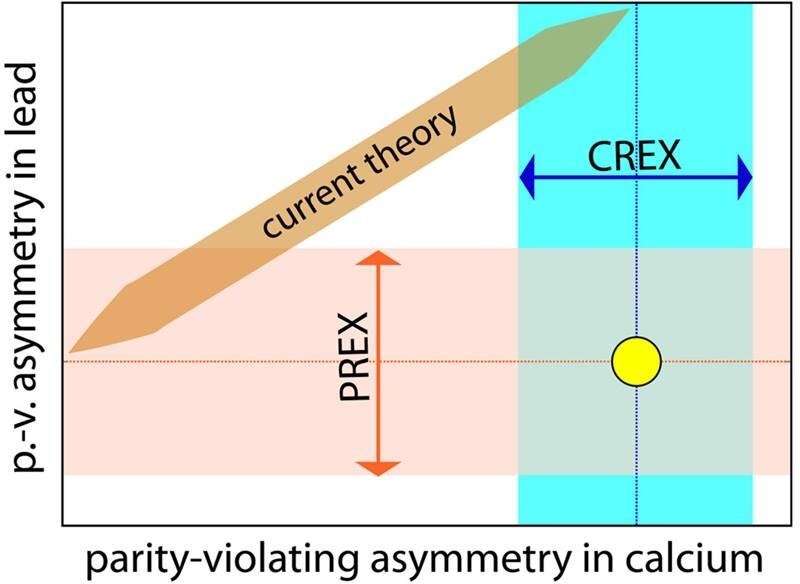This article has been reviewed according to Science X's editorial process and policies. Editors have highlighted the following attributes while ensuring the content's credibility:
fact-checked
peer-reviewed publication
trusted source
proofread
PREX, CREX, and nuclear models: The plot thickens

A team of theorists has extended their previous critical analysis of the Lead Radius Experiment (PREX). The experiment involved deducing the neutron size of a lead atom's nucleus by measuring a tiny left-right asymmetry in electron scattering off lead-208.
In a recent experiment (CREX), the asymmetry for calcium-48 has been measured. In their new analysis, the team found a disagreement between the CREX and PREX results and predictions of global nuclear models. This result indicates a need to investigate limitations of current nuclear models or other sources of uncertainty.
A typical radius of a neutron star is believed to be about 11 kilometers. The PREX results predict neutron star sizes that are appreciably bigger. This finding created significant buzz in the neutron star community. The disagreement between theory and experiment, or between the two measurements, means that scientists must exercise extreme caution when interpreting the new measurements. That caution applies to topics from neutron skins to nuclear symmetry energy to neutron star physics.
A team of theorists from the University of Erlangen–Nuremberg in Germany, the University of Milan in Italy, and the Facility for Rare Isotope Beams has conducted new analysis of recent results from nuclear physics experiments. The analysis involves recent experimental determination of the parity violating asymmetry in the isotopes calcium-48 and lead-208 at the Thomas Jefferson National Accelerator Laboratory.
Published in Physical Review Letters, this work is important for scientists' understanding of how neutrons and protons arrange themselves inside the atomic nucleus. To better understand the impact of these measurements, the researchers conducted a rigorous theoretical investigation of parity violating asymmetry of calcium-48 and lead-208 and assessed the associated uncertainties. They also inspected the static electric dipole polarizability in these nuclei.
The researchers concluded that the simultaneous accurate description of left-right asymmetry in lead-208 and calcium-48 cannot be achieved by the current models that accommodate a pool of global nuclear properties, such as masses and radii, throughout the nuclear chart.
More information: Paul-Gerhard Reinhard et al, Combined Theoretical Analysis of the Parity-Violating Asymmetry for Ca48 and Pb208, Physical Review Letters (2022). DOI: 10.1103/PhysRevLett.129.232501
Journal information: Physical Review Letters
Provided by US Department of Energy





















